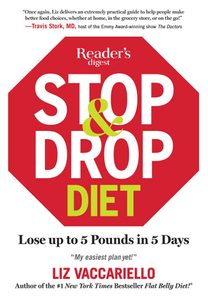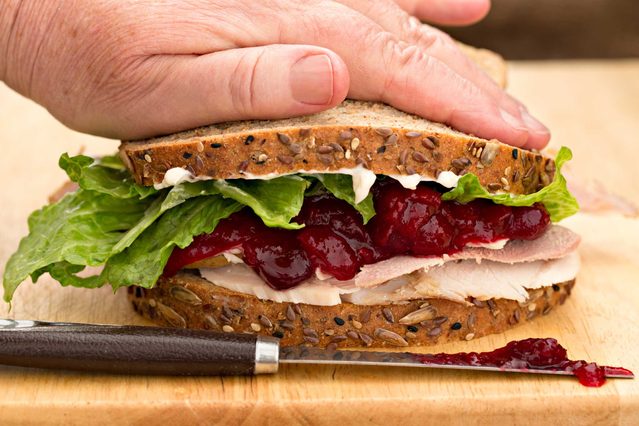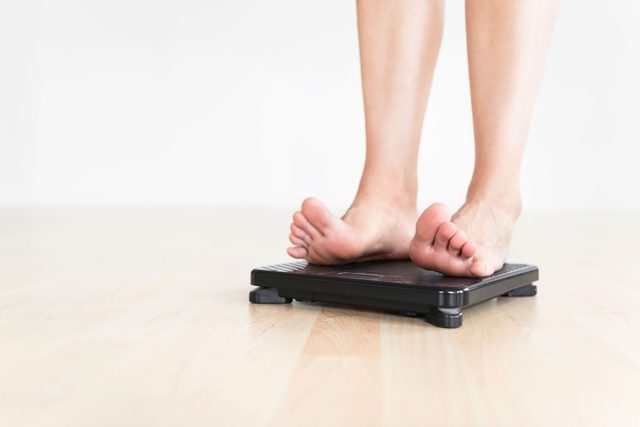8 Real Reasons You Can’t Lose Weight (And How to Get Out of the Rut)
Updated: Apr. 15, 2016
Stuck in a weight-loss plateau? These surprising factors may be preventing you from reaching your goal weight. Here’s how to outsmart these weight-loss roadblocks, from the new book ' Stop & Drop Diet.’
Click here to learn more about the Stop & Drop Diet.
1. You eat when you’re not hungry
A lot of us are slaves to the clock. When I was growing up, my mother had dinner on the table promptly at six o’clock. Even if I wasn’t especially hungry then, you can be sure I ate—and I cleaned my plate, because that’s what we did in our house. Who knows how many extra calories I ate that way? I’m not saying that your meals should be unplanned. In fact, it’s best to make sure you eat regularly to keep from getting so ravenous that you lose control and can’t stop eating. But if you’re in the habit of eating when the clock says to, instead of when you’re actually hungry—which researchers at the University of Minnesota found is one of the main reasons people eat when they do—you tend to lose touch with what “hungry” feels like and eat more than you really need.
Keep your schedule flexible if possible and listen to your tummy. On weekends, for example, I find that two main meals is all I need or want. I’ll linger over coffee (or go for a run), then find it’s 11, sometimes 12 o’clock before I’m hungry enough to want to eat. Or I’ll have a healthy breakfast, then get caught up in my day and have what I call an “afternoon dinner” at 3 or 4.
2. You eat when you’re distracted
Do you see crumbs or smudges on your computer keyboard, the touch screen of your phone, or your TV’s remote control? That’s a telltale sign that you’re doing other things while you’re eating. Don’t get me wrong. I’m all for multitasking, and I definitely have days when I eat in front of the computer. Here’s the problem. Ask me how it tasted and I might not be able to tell you, because I was preoccupied by my work.
Researchers in Ireland interviewed a group of 66 adults on what made portion control difficult. One of the main factors, they reported, were elements of the eating environment—socializing with friends and family, watching television, or working on a computer or phone—that diverted their attention away from what they were eating.
[pullquote]A review of two dozen studies showed that being distracted at one meal may even cause people to eat more later in the day[/pullquote].
Focus on what you’re eating, and I bet you’ll enjoy your food much more—and you’ll also enjoy knowing that you haven’t stuffed yourself with empty extra calories.
3. You dine out for every meal
Occasional indulgences are not the problem. What is: We are eating out more and more often—over a 40-year period from 1970 to 2010, we nearly doubled the percentage of calories we get from food away from home. And we are all too often unaware of how many calories are in the dishes we eat. A study of fast-food eaters in Philadelphia and Baltimore found that they underestimated their meal by up to 400 calories!
Restaurant meals tend to be higher in calories, saturated fat, and sodium than homemade meals, and lower in calcium, fiber, and other weight-friendly nutrients. I’m not saying you should never eat out—far from it—but one of the kindest things we could do for our waists and our overall health would be to eat out less often. If you’re in the habit of always grabbing a bagel on the way in to work, stock up instead on Nature’s Own Plain Thin- Sliced Bagels. If you like a deli hoagie for lunch, bring your own turkey sub. You get the idea. And when you do eat out, look for entrées that are grilled or baked, not fried or smothered in sauce, and for side dishes that pile on the veggies (again, you’re looking for steamed, sautéed, or otherwise simply prepared vegetables).
4. You’re a slave to “healthy brands”
If you’re trying to drop pounds and be healthy, your best bet is to choose foods from the restaurants and brands that emphasize fresh, whole ingredients and prepackaged portions, like Chipotle, Jamba Juice, KIND, Lean Cuisine, and Weight Watchers. Right? That’s what I thought before I started working on the Stop & Drop Diet. But picking healthy foods is not as simple as finding a “healthy” brand and sticking to it.
In a February 2015 New York Times article, a group of reporters gathered 3000 meal orders from Chipotle—which proudly proclaims on its website, “We’re all about simple, fresh food without artificial flavors or fillers”—and calculated the calories, saturated fat, and sodium in them. The typical order, a burrito, weighed in at more than 1000 calories! This isn’t to say that you can’t find a healthy meal at Chipotle. The same article highlights several Chipotle meals that clock in at around 545 calories, including crispy steak tacos, a veggie bowl, and a carnitas burrito, and it’s possible to get even lower by changing the fillings and toppings you choose.
KIND, another brand that touts itself as “healthy and tasty,” was recently taken to task by the FDA, which found that several of its products did not meet the requirements to use the claims “good source of fiber,” “no trans fats,” “low sodium”, “+ antioxidants,” and “+ protein,” among others. In its defense, KIND noted on its blog, “Nuts, key ingredients in many of our snacks and one of the things that make fans love our bars, contain nutritious fats that exceed the amount allowed under the FDA’s standard.” Having delved into the research on healthy fats for my first book, Flat Belly Diet!, I agree with KIND on this one. That said, many KIND bars are higher in calories or fat than, for instance, a Quaker or Nature Valley or Kashi bar. And some Quaker, Nature Valley, and Kashi bars may be higher in calories and/or sugars and/or sodium than some KIND bars.
Bottom line: Every restaurant and every brand has some dishes and products that are healthier than others. In order to get the full story about any given food, you need to look beyond the brand and beyond the health claims spouted in advertisements and printed on the front of the box.
5. You starve yourself
While it’s true that in order to lose weight, you need to eat less, that does not mean you need to starve yourself! In fact, starving yourself often has the opposite effect. To your body, your extra fat is a necessary hedge against the day that there’s no food to be had. We humans evolved during a time when there were no grocery stores or restaurants or even farms. How did our ancestors survive when there was a drought that killed off the leaves and berries they foraged? Or when they failed in the hunt? They lived off the fat they had built up during more plentiful times. Which is why, when you suddenly slash the amount of food you’re eating, your body reacts by hanging on to every bit of fat it can.
The same thing happens when you skip meals. Skip breakfast and you’re likely to overdo it at lunch since you’re so hungry. Skip lunch and you may be too ravenous by dinner to make smart food choices. A study of eight years of data from the National Health and Nutrition Examination Survey (NHANES) showed that people who skip breakfast tend to be heavier and have a larger waist than those who eat a healthy breakfast.
6. You have a list of “forbidden” foods
The Atkins Diet. The South Beach Diet. The Paleo Diet. The Dukan Diet. So many popular diets today recommend cutting out or drastically cutting down on carbohydrates that there must be something to the low-carb thing, right? Well, it’s true that, on average, Americans eat more carbs than we really need, especially refined carbohydrates like those in white bread, pasta, cakes, and cookies. Among our top sources of calories, in fact, are cakes and cookies, breads, pizza, pasta, and sugary drinks. So if you cut back on these foods, you will automatically slash your calorie consumption and lose weight. And, because excess consumption of refined carbs has been associated with diabetes, heart disease, and a host of other chronic diseases, you’ll be healthier if you eat fewer of them.
But of course, when you suddenly stop eating an entire food group, you are automatically cutting calories and your body reacts accordingly.
[pullquote]It thinks you’re starving and responds by slowing your metabolism and hanging on to every calorie it can.[/pullquote]
Plus, your body misses the nutrients it’s not getting. For example, dairy products are a top source of calcium, vitamin D, and potassium. Eliminate them and you’ll have to work hard to make up those nutrients. There’s a psychological aspect to it, too. Tell me I can’t have something or restrict the amount I can eat, and suddenly it’s the only thing I want. Next thing you know, you’re craving those forbidden foods like nobody’s business, and you feel like you’d mow down your own mother to get to a piece of bread.
The same is true for low-fat diets, low-salt diets, and pretty much any other diet that forbids specific foods. Which is not to say that these types of diets can’t be healthy. But most people find that they’re hard to sustain over time because they often require a lot of cooking or buying specialty food items. And a diet certainly won’t work if you don’t follow it.
7. You rely on dieting alone
While you can lose weight even if the only movement you make all day is walking from your bed to your desk chair, it’s much easier and faster to drop pounds if you combine diet and exercise. If you are burning an extra 200 to 300 calories per day, that’s 200 to 300 calories less you have to carve out from your diet to get the same calorie deficit. Plus, exercise generates natural endorphins, so you feel better and have more energy even if you are a little hungry. All of which makes it easier to stick with the diet.
And once you’ve lost the weight, exercise has also proven to be key to keeping it off. According to the National Weight Control Registry, established in 1994 to identify and investigate the characteristics of people who have successfully lost weight and kept it off for more than a year, 94 percent increased their physical activity in order to lose weight, with the most frequently reported form of exercise being walking. To keep it off, 90 percent report that they exercise an average of an hour a day.
8. You feel bad about your weight
If you get depressed every time you step on a scale, or only see your fat butt when you look in the mirror, or refuse to have a photo taken because you’re ashamed of what you look like, then you need to stop. No matter what you weigh, if you don’t love your body, you will never truly win the weight loss battle. If you feel guilty about your eating habits and ashamed of your body, you will always feel deprived. While you may lose weight initially on the diet, you will soon slide back to your old food choices and gain it all back again.
[pullquote]The only way to finally, truly lose the weight and keep it off for good is to stop feeling bad about your weight and your body.[/pullquote]
If you love and respect your body, it will not feel like a chore to research restaurant entrees before you go out to eat or to read nutrition labels in the grocery store or to cook for yourself and your family. Instead, it will be a privilege to take care of yourself by making smart, healthy food choices.
Focus on how much better you feel physically and mentally. One study showed that people who reported feeling alive and energetic were more motivated and more successful at maintaining their weight loss.
 Reader’s Digest’s Editor in Chief Liz Vaccariello calls her latest book, Stop & Drop Diet, her easiest plan ever. The book and online course teach you how to stop eating unhealthy versions of the foods you love so you can drop up to five pounds in the first five days—and keep losing. You’ll get a mix-and-match 21-day meal plan designed for weight loss and balanced nutrition, plus hundreds of easy weight loss tips and tricks via videos, quizzes, slideshows, and other interactive tools. Learn more and buy the book and course here.
Reader’s Digest’s Editor in Chief Liz Vaccariello calls her latest book, Stop & Drop Diet, her easiest plan ever. The book and online course teach you how to stop eating unhealthy versions of the foods you love so you can drop up to five pounds in the first five days—and keep losing. You’ll get a mix-and-match 21-day meal plan designed for weight loss and balanced nutrition, plus hundreds of easy weight loss tips and tricks via videos, quizzes, slideshows, and other interactive tools. Learn more and buy the book and course here.



